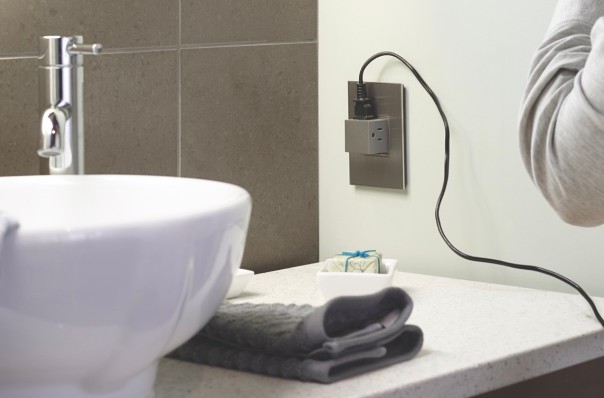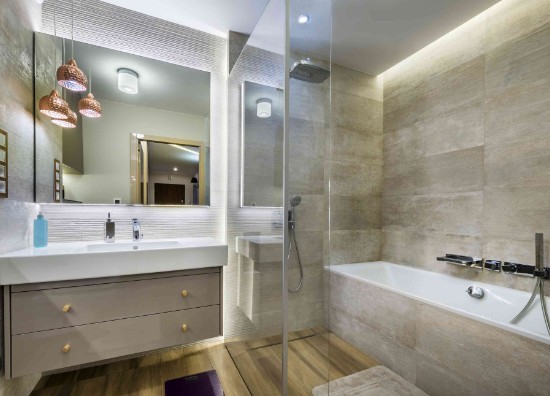Running appliances like electric razors, hair dryers, electric toothbrushes, and even bathroom lighting would be impossible without electricity in your bathroom.
However, you must ensure it is in the correct circuit to ensure everything runs well, so can a bathroom be on a 15 amp circuit?
A bathroom can be on a 15-amp circuit. However, electrical code requirements can differ based on location. A 15-amp circuit can handle a typical residential bathroom’s electrical load, which includes outlets, lighting fixtures, exhaust fans, and heating elements like electric towel warmers.
However, it’s always best to consult with a local electrician or refer to your local building codes for specific guidelines. In that case, keep reading to discover more about bathroom electrical connections.

Can A Bathroom Be On A 15 Amp Circuit?
As mentioned above, you can use a 15-amp circuit in your bathroom. However, consider these:
1. GFCI Protection
Bathrooms typically require Ground Fault Circuit Interrupter (GFCI) protection. GFCI outlets or circuit breakers quickly detect any imbalances in the electrical current and shut off power to prevent electrical shocks.
Ensuring all bathroom outlets, including bathroom lighting, are GFCI protected is essential.
2. Appliance and Fixture Requirements
Different appliances and fixtures in the bathroom have specific electrical requirements. Therefore, consider the electrical needs of your bathroom appliances and fixtures to ensure the circuit is appropriately sized.
When using a 15-amp circuit, ensure the total electrical load of all devices connected to the circuit does not exceed the 15-amp capacity.
Common bathroom devices include lighting fixtures, exhaust fans, electric shavers, hairdryers, curling irons, and towel warmers. Check each device’s wattage or amperage rating and calculate the cumulative load to ensure it remains within the circuit’s capacity.
You may need to consider higher amperage ratings if you have multiple bathrooms or additional power-hungry devices in the bathroom to accommodate the increased load.
3. Dedicated Circuits
Besides higher amperage circuits, dedicated circuits come in handy when you have high-power appliances. These include whirlpool tubs, saunas, or multiple heat-producing devices in your bathroom.
Dedicated circuits ensure these power-hungry devices have their dedicated electrical supply without overloading the general circuit.
4. Wiring and Electrical Codes
Following local electrical codes and regulations is crucial when installing or modifying electrical circuits in a bathroom. So, refer to local codes since they may specify wiring methods, outlet placement, GFCI requirements, and other safety guidelines.
5. Upgrades and Renovations
Since 15 amp circuits handle light bathroom electrical needs, consider reviewing and updating your electrical system when making significant renovations.
An electrician can help you assess your electrical needs, determine if any circuit upgrades or additions are necessary, and ensure your bathroom remains safe and up to code.
Should A Bathroom Circuit Be 15 Or 20 Amp?
A bathroom circuit can be 15 amp or 20 amp. The choice between them depends on various factors, including local electrical codes, your bathroom’s electrical load requirements, and the specific devices or appliances you plan to use.
A 20 amp circuit is better if the cumulative load of the devices you plan to use is higher. Also, a 20-amp circuit may provide more flexibility and accommodate increased electrical demand if you anticipate installing high-power devices or adding more outlets in the future.
Do Bathroom Outlets Need To Be On A Dedicated Circuit?
According to electrical codes in many jurisdictions, bathroom outlets typically need to be on a dedicated circuit. However, since electrical codes can vary, consult your local building codes or a licensed electrician to confirm the specific requirements in your area before any installations.
The primary reason for requiring dedicated circuits for bathroom outlets is to ensure electrical safety. Bathrooms often have high-power appliances such as hairdryers, curling irons, and electric shavers that can draw a significant amount of electrical current.
Therefore, dedicated circuits allow these devices to operate without overloading the circuit or causing a tripped breaker.
Furthermore, dedicated circuits for bathroom outlets reduce the risk of power disruptions or nuisance tripping, an issue you may experience if you connect the bathroom outlets to a shared circuit with other areas of your house.
For instance, power to the bathroom can be interrupted when you use other appliances or devices on that circuit.
Additionally, dedicated circuits provide greater flexibility for future upgrades or additions since they can handle the increased load without affecting other areas of the house.
Therefore, consider fitting in dedicated circuits if you plan to install new bathroom devices or fixtures that require additional electrical capacity.
Note
It would be best to hire a licensed electrician, especially if you have limited knowledge on the subject, to assess your specific needs and install dedicated circuits for bathroom outlets if required by local regulations. This will ensure compliance with electrical codes and optimal electrical safety.

Does A Bathroom Fan Need Its Own Circuit?
A bathroom fan does not necessarily need its dedicated circuit. However, it can provide added convenience and safety, particularly if the bathroom has other high-power devices.
Also, you will need a dedicated circuit if the cumulative load of all the devices on the circuit, including the fan, exceeds the amp rating of the circuit (usually 15 or 20 amps).
How Many Circuits Should A Bathroom Have?
The number of circuits a bathroom should have varies depending on several factors. These include local electrical codes, the size and layout of the bathroom, and the electrical load requirements.
However, while specific requirements may vary, here are some general guidelines:
a) General Circuit
Most bathrooms have at least one general-purpose circuit that powers outlets, lighting fixtures, and potentially the exhaust fan. This circuit is typically 15 or 20 amps and should be equipped with Ground Fault Circuit Interrupter (GFCI) protection.
b) Dedicated Circuit
You will need a dedicated circuit if your bathroom has high-power devices that require more electrical capacity. These devices may include items like whirlpool tubs, saunas, electric towel warmers, or heating elements.
A dedicated circuit ensures these devices have their own dedicated electrical supply without overloading the general circuit.
c) Lighting Circuit
While lighting fixtures can be included in the general circuit, your bathroom can also have a separate lighting circuit for convenience. This allows you to control your bathroom lighting independently and can be useful if you want to use the bathroom without powering the exhaust fan or other devices.
d) Specialty Circuits
Depending on the specific features of your bathroom, you may require additional circuits for specialized equipment. For example, if you have built-in speakers, audio systems, or advanced automation systems, they may require separate circuits.
Can Bathroom Lights And Outlets Be On Same Circuit?
Bathroom outlets and lights can be on one circuit. In fact, it is pretty common to have a single circuit that powers both the lighting fixtures and the outlets in a bathroom, as this setup provides convenience and simplifies the wiring process.
However, the electrical load of the lights and outlets, along with any other devices connected to the circuit, must not exceed the amp rating of the circuit (usually 15 or 20 amps).
Therefore, it is crucial to calculate the total electrical load of all the devices and fixtures on the circuit to ensure it remains within the circuit’s capacity.
Additionally, have GFCI protection for all outlets in your bathroom.
Can Bathrooms Share A Circuit?
Multiple bathrooms can share a circuit. You will commonly find bathrooms located in close proximity, especially in residential settings, sharing a circuit to simplify the electrical wiring.
However, ensure the total electrical load of all the devices and fixtures in both bathrooms does not exceed the circuit’s amp rating should you decide to use a shared circuit.
This includes considering the lighting fixtures, outlets, exhaust fans, and other devices connected to the circuit in both bathrooms.
What Are The Requirements For Outlets In A Bathroom?
Here are some common requirements for outlets in a bathroom:
a) Ground Fault Circuit Interrupter (GFCI) Protection
All outlets in a bathroom must have GFCI protection. GFCI protection is crucial in areas where water is present to minimize the risk of electrical accidents.
b) Outlet Placement
You must place the outlets in your bathroom in specific locations, typically within 36 inches of the edge of a sink basin. This ensures convenient access to electrical power for devices like electric shavers or hairdryers while minimizing the risk of water coming into contact with the outlet.
c) Distance from Water Sources
For your safety, ensure the outlets in your bathroom are a safe distance away from water sources, such as sinks, bathtubs, showers, and bidets. While specific regulations may vary, a general guideline is to keep outlets at least 6 feet away horizontally from water sources or install them at a higher height.
d) Tamper-Resistant Receptacles
Many jurisdictions require tamper-resistant receptacles for outlets in bathrooms. These outlets have built-in mechanisms that prevent the insertion of foreign objects, providing an added level of safety, especially in households with young children.
e) Number of Outlets
There is typically no minimum or maximum number of outlets required in a bathroom. However, have an adequate number of outlets to meet the electrical needs of the space.
Also, consider the placement of lighting fixtures, exhaust fans, and other devices requiring electrical power.

Can I Use A 20 Amp Outlet On A 15 Amp Circuit?
Using a 20 amp outlet on a 15 amp circuit is not recommended because the outlet’s amp rating should match or be lower than the amp rating of the circuit it is connected to.
A 20 amp outlet is designed to handle a maximum load of 20 amps, while a 15 amp circuit is designed to handle a maximum load of 15 amps.
Therefore, using a 20 amp outlet on a 15 amp circuit and connecting devices that draw more than 15 amps can overload the circuit, leading to overheating, tripped breakers, or other electrical hazards.
Using an outlet with a higher amp rating than the circuit can also cause compatibility issues and may not provide adequate protection for the connected devices.
Moreover, Using an outlet with a higher amp rating than the circuit can compromise the electrical system’s integrity and increase the risk of electrical problems, including fires and damage to the wiring.
In Conclusion, Can A Bathroom Be On A 15 Amp Circuit?
Your bathroom will either be on a 15 amp or 20 amp circuit, with the appropriate choice resting on your needs, plans, and local codes. Nonetheless, ensure you choose a circuit with sufficient capacity for your bathroom.
Here’s another related topic:
